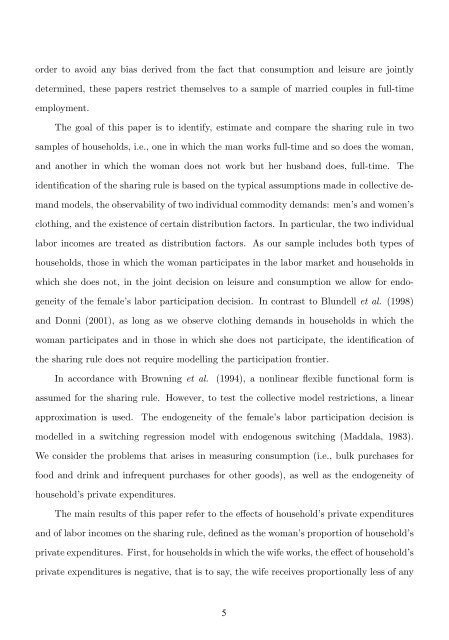THE SPANISH SHARING RULE* Bernarda Zamora - Ivie
Create successful ePaper yourself
Turn your PDF publications into a flip-book with our unique Google optimized e-Paper software.
order to avoid any bias derived from the fact that consumption and leisure are jointly<br />
determined, these papers restrict themselves to a sample of married couples in full-time<br />
employment.<br />
The goal of this paper is to identify, estimate and compare the sharing rule in two<br />
samples of households, i.e., one in which the man works full-time and so does the woman,<br />
and another in which the woman does not work but her husband does, full-time.<br />
The<br />
identification of the sharing rule is based on the typical assumptions made in collective demand<br />
models, the observability of two individual commodity demands: men’s and women’s<br />
clothing, and the existence of certain distribution factors. In particular, the two individual<br />
labor incomes are treated as distribution factors. As our sample includes both types of<br />
households, those in which the woman participates in the labor market and households in<br />
which she does not, in the joint decision on leisure and consumption we allow for endogeneity<br />
of the female’s labor participation decision. In contrast to Blundell et al. (1998)<br />
and Donni (2001), as long as we observe clothing demands in households in which the<br />
woman participates and in those in which she does not participate, the identification of<br />
the sharing rule does not require modelling the participation frontier.<br />
In accordance with Browning et al.<br />
(1994), a nonlinear flexible functional form is<br />
assumed for the sharing rule. However, to test the collective model restrictions, a linear<br />
approximation is used.<br />
The endogeneity of the female’s labor participation decision is<br />
modelled in a switching regression model with endogenous switching (Maddala, 1983).<br />
We consider the problems that arises in measuring consumption (i.e., bulk purchases for<br />
food and drink and infrequent purchases for other goods), as well as the endogeneity of<br />
household’s private expenditures.<br />
The main results of this paper refer to the effects of household’s private expenditures<br />
and of labor incomes on the sharing rule, defined as the woman’s proportion of household’s<br />
private expenditures. First, for households in which the wife works, the effect of household’s<br />
private expenditures is negative, that is to say, the wife receives proportionally less of any

















